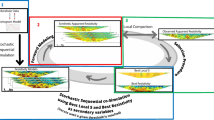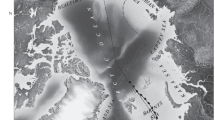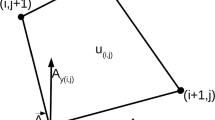Abstract
In solving the problems of shallow depth electrical prospecting of the daylight surface, the topography is a factor that has a significant impact on the results of the inversion of electrical resistivity tomography data. Verification of the results of inversion of the field data is a laborious task due to the complex structure of the original geological medium. At the same time, the development of computer numerical simulation methods allows obtaining electrical resistivity tomography data for simple models of the medium. The results of estimating the effect of the simplest landforms on the results of the inversion of electrical resistivity tomography data obtained by numerical simulation by the example of the model of a trench with the triangular cross-section are presented. Numerical simulation is performed based on the finite element method by an inversion-independent technique. It is determined that the inversion of the tomography data for the trench in a homogeneous half-space produces false anomalies, with the maximum located under the axis of the trench. It is shown separately that in the presence of real inhomogeneity at this position, it can, depending on its resistance, be masked (compensated) by the false anomaly, or strengthen it. If the trench is in a two-layer medium, then there is a distortion of the boundary between the layers at some interval under the trench, repeating the trench shape.





Similar content being viewed by others
REFERENCES
Advanced Geosciences, Inc., EarthImager 2D resistivity imaging software. https://www.agiusa.com/agi-earthimager-2d. Accessed July 1, 2020.
Chanturishvili, L.S., Spetsial’nye zadachi elektrorazvedki pri proektirovanii dorog (Special Problems of Electrical Surveys when Designing Roads), Moscow: Transport, 1983.
Demirchyan, K.S. and Chechurin, V.L., Mashinnye raschety elektromagnitnykh polei (Machine-Assisted Calculation of Electromagnetic Fields), Moscow: Vysshaya shkola, 1986.
Geotomo Software, RES2DINVx64 ver. 4.09. http://geotomosoft.com/r2dimanu.zip/Res2dinvx64.pdf. Accessed July 1, 2020.
Kaznacheev, P.A., Development and study of the complex of tools for active geoelectrical monitoring using local current gauges, Extended Abstract of Cand. Sci. (Tech.) Dissertation, Moscow, 2014.
Kaznacheev, P.A., Kamshilin, A.N., and Popov, V.V., Measurement of local current density in the earth’s crust, Vestn. Mosk. Energ. Inst., 2011, no. 5, pp. 57–63.
Loke, M.H., Topographic modelling in resistivity imaging inversion, 62nd EAGE Conference and Technical Exhibition, Glasgow, Scotland, 2000.
Loke, M.H., Electrical resistivity surveys and data interpretation, in Encyclopedia of Solid Earth Geophysics, Gupta, H., Ed., Springer-Verlag, 2011, 2nd ed., pp. 276–283.
Loke, M.H., Chambers, J.E., Rucker, D.F., Kuras, O., and Wilkinson, P.B., Recent developments in the direct-current geoelectrical imaging method, J. Appl. Geophys., 2013, vol. 95, pp. 135–156.
Loke, M.H., Wilkinson, P.B., Chambers, J.E., and Meldrum, P.I., Rapid inversion of data from 2-D resistivity surveys with electrodes displacements, Geophys. Prospect., 2018, vol. 66, no. 3, pp. 579–594. https://doi.org/10.1111/1365-2478.12522
Mirgalikyzy, T., Mukanova, B., and Modin, I., Method of integral equations for the problem of electrical tomography in a medium with ground surface relief, J. Appl. Math., 2015, vol. 2015. https://doi.org/10.1155/2015/207021
Pryor, R., Multiphysics Modeling Using COMSOL, Jones and Bartlett, 2011.
Robain, H. and Bobachev, A., X2IPI: Tool box for 2D DC mea-surements with SYSCAL equipment. User manual. http:// media.voog.com/0000/0038/0901/files/X2IPI_manual.pdf. Accessed July 1, 2020.
Svetov, B.S., Osnovy geoelektriki (Fundamentals of Geoelectrics), Moscow: LKI, 2008.
Vishnyakov, S.V., Gordyukhina, M.N., and Fedorova, E.M., Raschet elektromagnitnykh polei s pomoshch’yu programmnogo kompleksa ANSYS (Calculation of Electromagnetic Fields Using the ANSYS Software Complex), Moscow: Mosk. Energ. Inst., 2003.
Zhdanov, M.S., Elektrorazvedka (Electrical Survey), Moscow: Nedra, 1986.
Zhostkov, R.A., Improving certain means of seismic exploration by using data on Rayleigh wave scattering on relief, Bull. Russ. Acad. Sci.: Phys., 2018, vol. 82, no. 11, pp. 1416–1420.
Zond Software, ZondRes2D program for two-dimensional interpretation of data obtained by resistivity and induced polarization methods. http://zond-geo.com/zfiles/Zondres2d.zip/ ZondRes2D_eng.pdf. Accessed July 1, 2020.
Funding
The studywas carried out under the state task of the Schmidt Institute of Physics of the Earth, RAS, and was supported in part by the Russian Foundation for Basic Research (project no. 18-35-00698 mol_a (statement of the verification problem for numerical simulation procedure of a DC electric field in layeredmedia).
Author information
Authors and Affiliations
Corresponding author
Additional information
Translated by L. Mukhortova
About this article
Cite this article
Kaznacheev, P.A., Popov, I.Y., Modin, I.N. et al. Application of Independent Finite Element Modeling for Estimating the Effect of Simplest Landforms on Results of Inversion of Electrical Resistivity Tomography Data (Example of a Trench with the Triangular Cross-Section). Seism. Instr. 56, 531–539 (2020). https://doi.org/10.3103/S0747923920050084
Published:
Issue Date:
DOI: https://doi.org/10.3103/S0747923920050084




